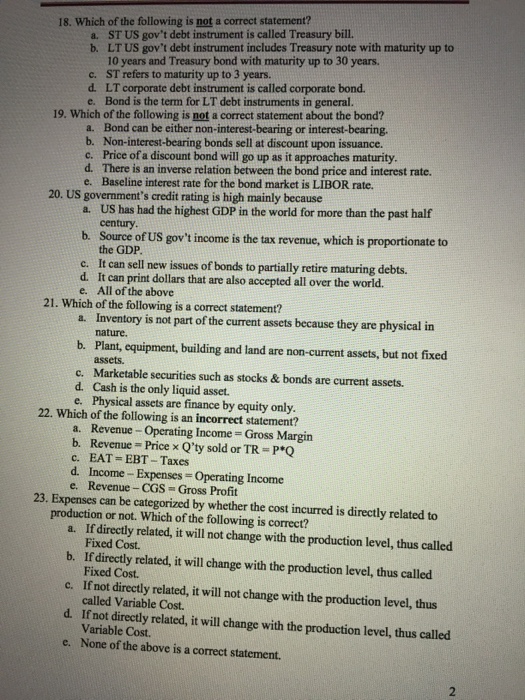Which of the following is not a correct statement? a. ST US gov't debt instrument is called Treasury bill. b. LT US gov't debt instrument includes Treasury note with maturity up to 10 years and Treasury bond with maturity up to 30 years. c. ST refers to maturity up to 3 years. d. LT corporate debt instrument is called corporate bond. e. Bond is the term for LT debt instruments in general. Which of the following is not a correct statement about the bond? a. Bond can be either non-interest-bearing or interest-bearing. b. Non-interest-bearing bonds sell at discount upon issuance. c. Price of a discount bond will go up as it approaches maturity. d. There is an inverse relation between the bond price and interest rate. e. Baseline interest rate for the bond market is LIBOR rate US government's credit rating is high mainly because a. US has had the highest GDP in the world for more than the past half century. b. Source of US gov't income is the tax revenue, which is proportionate to the GDP. c. It can sell new issues of bonds to partially retire maturing debts. d. It can print dollars that are also accepted all over the world. e. All of the above Which of the following is a correct statement? a. Inventory is not part of the current assets because they are physical in a. nature. b. Plant, equipment, building and land are non-current assets, but not fixed assets. c. Marketable securities such as stocks & bonds are current assets. d. Cash is the only liquid asset. e. Physical assets are finance by equity only. Which of the following is an incorrect statement? a. Revenue-Operating Income = Gross Margin b. Revenue = Price times Q'ty sold or TR = P*Q c. EAT = EBT-Taxes d. Income-Expenses = Operating Income e. Revenue- CGS = Gross Profit Expenses can be categorized by whether the cost incurred is directly related to production or not. Which of the following is correct? a. If directly related, it will not change with the production level, thus called Fixed Cost. b. If directly related, it will change with the production level, thus called Fixed Cost. c. If not directly related, it will not change with the production level, thus called Variable Cost. d. If not directly related, it will change with the production level, thus called Variable Cost. e. None of the above is a correct statement







